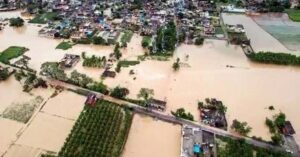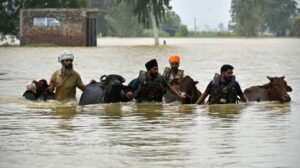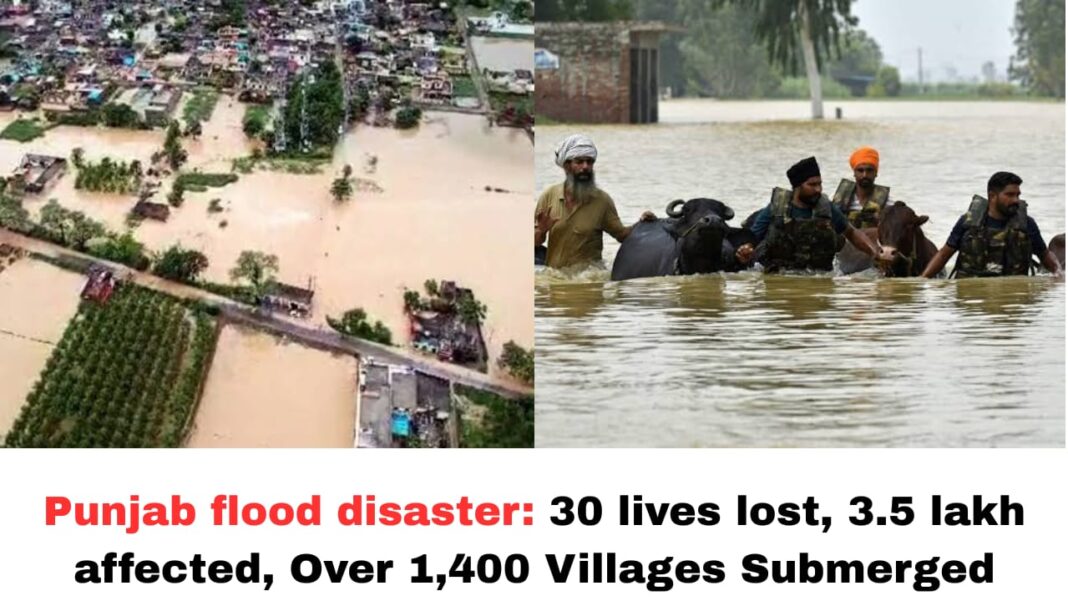Digital News Guru Punjab Desk:
From 1988 to 2025: Punjab Faces Its Most Catastrophic Flooding in Decades
Punjab, long known as India’s breadbasket, is enduring one of its most severe natural disasters in nearly four decades. As of September 3, 2025, the state has been officially declared disaster-affected, with all 23 districts grappling with catastrophic flooding. The situation, intensified by relentless monsoon rains and releases from upstream dams, is widely regarded as surpassing even the infamous 1988 floods in scale and devastation.
The Scale of the Crisis
At least 30 to 37 lives have been lost so far, with the death toll continuing to climb. Over 1,200 to 1,400 villages are submerged, affecting approximately 3.5 lakh (350,000+) residents. In many areas, standing crops have been drowned just weeks before harvest, with estimations ranging from 1.48 lakh hectares to 3.75 lakh acres lost to floodwaters.

Rivers—the lifeblood of the region—have turned into perilous torrents. The Sutlej, Beas, and Ravi, already swollen by monsoon deluges, overflowed catastrophically, further fueled by sudden water releases from dams in upstream catchment areas like Himachal Pradesh and Jammu & Kashmir.
Historic Echoes: 1988 and Beyond
Chief Minister Bhagwant Mann likened the unfolding disaster to the devastating floods of 1988, when over 9,000 villages were submerged and more than 3.4 million people were impacted. The comparison carries weight—today’s crisis mirrors that level of destruction and human suffering.
Other floods, like those in 1993, wreaked havoc as well, with around 350 fatalities in Punjab and over 1.2 million acres of crop damage. Yet, the current disaster’s breadth—from 23 districts to widespread agricultural loss—underscores its unprecedented nature.
Immediate Humanitarian Response
Rescue and relief efforts are in full throttle. Nearly 20,000 people have been evacuated, primarily from villages in critical regions such as Gurdaspur, Amritsar, Kapurthala, Tarn Taran, and Ferozepur. Schools, colleges, and educational institutions across the state have been closed until at least September 7 to ensure safety.

District authorities have been empowered under Section 34 of the Disaster Management Act, 2025, allowing urgent action where needed. Departments like Public Works, Water Resources, Power, and telecom are working on a “war-footing” basis to restore infrastructure and communication links.
Food Bowl Underwater: Punjab’s Agricultural Heart Hit by Floods
Punjab’s agricultural heart—its paddy fields—is particularly hard-hit. Estimates of submerged farmland vary:
- 1.48 lakh hectares reported damaged
- Up to 3.75 lakh acres of fields under water, threatening food security and livelihoods
Farmers face impending harvest losses, rising debt, and economic distress. The collapse of “dhussi bundhs” (temporary embankments) and poor infrastructure maintenance have compounded the disaster.
Political and Administrative Actions
Chief Minister Mann has urged the Center to release Rs 60,000 crore in pending relief funds from national and state disaster response reserves, along with revised compensation norms. Mann has proposed increasing compensation to Rs 50,000 per acre, up from the current Rs 15,000, to better reflect the immense losses suffered.

Top officials, including both Mann and Governor Gulab Chand Kataria, have toured disaster-hit areas by boat. Kataria has appealed for permanent land rights for farmers, enabling better access to compensation schemes.
Lessons and Future Resilience
Experts point to long-standing structural failures: embankment weakness, floodplain mismanagement, and inadequate drainage. Studies by the Punjab Remote Sensing Centre (PRSC) suggest that nearly 18–19% of the state’s area was submerged in 1988 and 1993, similar to today’s sprawling inundations.
In response, some farmers are offering land for permanent embankments to prevent future floods. Amid mounting climate threats, such forward-looking measures may become critical.
Concluding Thoughts
Punjab is enduring a crisis that transcends decades—where hundreds of lives are lost, fields vanish under water, and communities are uprooted. The scale of the deluge, compared to 1988, underscores the accelerating challenges of climate-induced extreme weather.
You May Also Read: Udaipur Court Sentences Husband to Death for Killing Wife Over Her Dark Skin








